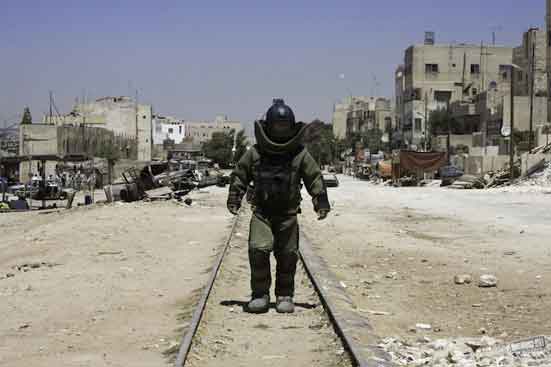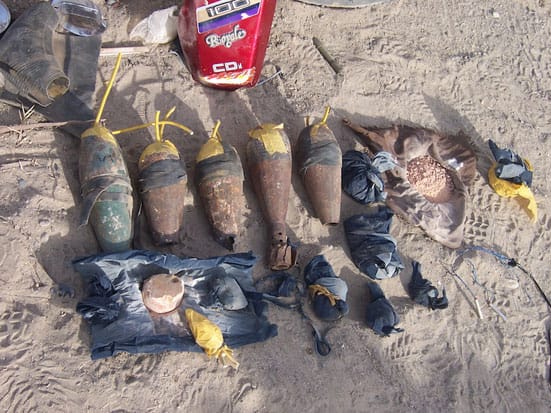The opening shot of ‘The Hurt Locker’ is through the grainy camera of a bomb disposal robot as it trundles towards a suspected Improvised Explosive Device (IED) beside the road somewhere in contemporary Baghdad. We cut to the soldier remotely operating the ‘bot, waggling joysticks and switches, and trying to persuade the robot’s clumsy pincers to lift the edges of a suspect tarpaulin. Sure enough, a dark metal bomb is uncovered, and in order to safely dispose of it an impossibly rickety trailer (a relic of some previous combat perhaps, or an improvised tool that’s never been bettered by something more technologically esoteric) is loaded with detonators, attached to the ‘bot and sent creaking across the kill-zone. Halfway there, while juddering over some particularly substantial debris, one of the trailer’s wheels pops off, and so, portentously, one of the team has to suit-up and walk out there to deliver the explosive payload by hand, thus defeating the prudence of using a robot in the first place.
The technologies of war are polarised in ‘The Hurt Locker’. The advanced, multi-billion-dollar, laboriously researched bits of kit wielded by the Americans routinely jam, break down, or are rendered impotent by the insurgent’s antithetically crude, ‘radio-shack’ technologies. As official parlance poetically has it, the bombs secreted beneath innocuous piles of rubbish are ‘improvised’; cobbled-together with an urgent, untrained hand and deposited indiscriminately. This improvisational method – borne of an absurd imbalance between the opposing forces and, implicitly, the cultural gulf separating them – belies what seems to be an insuperable advantage the insurgents have to react and change instantaneously to the advances of the enemy; to operate unhindered by protocol and bulky jurisprudence. In fact, the tacit condition of the insurgents in this film is, perversely, their freedom. It is the American soldiers who are cooped-up in dark barracks and armoured cars; padded suits, stifling helmets, their tour of duty and – above all else – their western, Christian morality. On the other hand, the insurgents are free to roam with native fluidity, and, apparently, kill and maim with cool indifference. The technological division between the Americans (and vicariously, we the western viewers), and the insurgents (and vicariously, the Iraqis) becomes analogous to war and compunction for violence. It is one of the film’s necessary flaws that the insurgents remain resolutely alien, glimpsed down the sight of a rifle. The war in Iraq remains appallingly impalpable, even and particularly it seems, to the soldiers engaged in the fighting. Distance – in all senses of the word – from the war and its participants, means that the dichotomy between the alienation of the insurgents and the affecting intimacy of the American soldiers somewhat unhappily maintains the distance of us, the audience members. The chief movement of this war for the west is, it seems, one of glacially steady remove; and sudden, violent and intimate return.
One of the most resonant aspects of ‘The Hurt Locker’ is its contemporaneity. The war depicted is happening now, and the fictional action that takes place within the film is mimetic of events that unfold every evening on the news. It’s a rare authenticity that lends the film a complex importance – not least because of its essential political ambiguity. The outcome of this real war remains unknown, and so must the film’s context – it can only represent as much as it knows, which stems like a pollutant from the fragility of reason for this war (and the war in Afghanistan in different but similar ways), infecting every action within it. The fictional narrative of the film is then, more than anything, allegorical – albeit an allegory that perversely contains no finite moral message. However, the ambiguity of the film’s stance is somewhat countered by its dramatic pedigree. It’s worth noting that ‘The Hurt Locker’ is utterly thrilling, compelling, suspenseful, nerve-shredding, and any number of other superlatives whose criteria is cinematic. The characters themselves are highly developed, interacting with terrific humanity – but it’s a balancing act, a necessary narrative compensation for the inherent irresolution and purposelessness of the situation. The unit are plunged into terrifying situations with fatal regularity, and the ever-present prospect of death is made immeasurably tenser because of the possibility that their plight is fundamentally aimless. This authenticity – authenticity as the site of the film’s narrative – means that the film’s role will evolve in parallel with the war, acting as a marker for a location somewhere near the middle of the conflict – too deep in the mire to go back, but with no destination in sight. At the moment, the success of the film is in dramatically representing something we must assume is going on right now (and that docudrama with all its requisite finite climaxes), whilst maintaining the indeterminacy of what the future might hold for Iraq.
Ed Atkins

The Hurt Locker

Improvised Explosive Devices (IEDs)